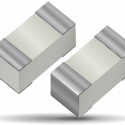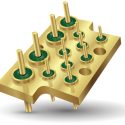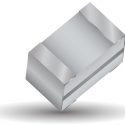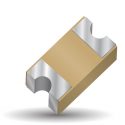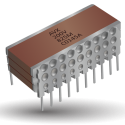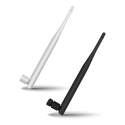Laser Direct Structuring (LDS): Working Principles and Benefits for RF Applications Written By: Youssef Laamimat Abstract: The growing prevalence of electronic devices presents a challenge to numerous industries and markets. Addressing the industry’s need for lighter and more compact components, LDS stands out as an excellent choice. In addition, it accelerates prototype production and streamlines time-to-market. Laser Direct Structuring (LDS) technology is a revolutionary approach offering a streamlined and efficient process for creating complex 3D circuits on a myriad of substrates. LDS technology is ideal when more curves are needed or less 3D volume is available. In RF applications such as antennas, this allows the manufacture of highly intricate designs, reduces assembly costs of having the antenna outside the device,
RF Microwave / Thin Film
Surface Mount Thermal Conductors for Heat Management Written By: Jern Ng Abstract: Efforts to miniaturize electronics are becoming increasingly common as designers work to fit more components into smaller packages, offering low-weight, low-volume products. The continuous march toward electronic miniaturization brings to light one primary challenge: the dissipation of heat. As semiconductor manufacturing realizes smaller feature sizes, microprocessor capability is simultaneously advancing with greater functionality.
Practical Capacitor Tolerance Selection for Coupling, DC Blocking and Bypass Applications Abstract: Proper selection of suitable capacitor tolerances is governed to a great extent by the type of application under consideration. This point should always be taken into account when designing for the best balance between cost and performance. For example, DC blocking, coupling and bypassing applications are not very sensitive to the variations in capacitor value that are due to the choice of wide spread tolerances. In contrast, applications such as filtering and matching will usually require narrow spread capacitance tolerances in order to meet the specific demands of those designs.
ESR Losses in Ceramic Capacitors Abstract: In the world of RF ceramic chip capacitors, Equivalent Series Resistance (ESR) is often considered to be the single most important parameter in selecting the product to fit the application. ESR, typically expressed in milliohms, is the summation of all losses resulting from dielectric (Rsd) and metal elements (Rsm) of the capacitor, (ESR = Rsd + Rsm). Assessing how these losses affect circuit performance is essential when utilizing ceramic capacitors in virtually all RF designs.
Considerations for Optimal Capacitive Coupling Abstract: Capacitors used in coupling and DC blocking applications serve to couple RF energy from one part of a circuit to another and are implemented as series elements. Proper selection of coupling capacitors insures the maximum transfer of RF energy. All capacitors will block DC by definition; however, considerations for satisfying the requirements of a coupling application depend on various frequency-dependent parameters that must be taken into account beforehand.
Capacitors in Broadband Applications Abstract: Proper selection of capacitors for RF broadband applications requires careful evaluation of frequency dependent parameters and certain design requirements. In today’s rapidly expanding RF and microwave markets, numerous designs must operate over multiple octaves of frequency spectrum. Some of the more common of these include broadband bias networks such as transistor emitter and FET source bypassing, transistor collector and FET drain feed structures, as well as interstage RF coupling, DC blocking, and wideband impedance matching.
Capacitor Pi Network for Impedance Matching Application Note 026 Abstract: Designing matching networks is one of the key aspects of RF/Microwave design. A lossless network that matches an arbitrary load to real impedance has to have at least two reactive elements. However, two elements do not give control over the bandwidth and the degree of match simultaneously. Three-element matching networks, i.e. Pi- and Teenetworks, provide additional control of the frequency response.
RF Ceramic Chip Capacitors in High RF Power Applications Abstract: In today’s world of wireless communications systems there are a myriad of high RF power applications that necessitate the use of high quality specialized ceramic chip capacitors. These demands require the designer to carefully account for factors such as device power dissipation and maximum current and voltage ratings as well as thermal resistance and temperature rise during normal circuit operation. This article highlights some of the most essential elements needed for selecting capacitor products suitable for these applications.
EMI Filtering for High-Reliability Applications Amanda Ison KYOCERA AVX Components Corporation Electromagnetic interference (EMI), or electrical noise, is generated by everything from cellphones to solar flares and can make accurate signal transmission as difficult as trying to have a clear conversation in a noisy room. To improve signal clarity in electronic circuits, device designers turn to EMI suppression filters. Effective EMI filtering is necessary for almost every modern electronic device, including devices that generate their own EMI, as well as devices that are sensitive to EMI within their environment, and is especially important in high-reliability applications that utilize lower-power signals and have strict signal fidelity demands. High-reliability EMI filters are designed to consistently meet or exceed performance requirements and are
Wireless Charging Written By: Ron Demcko Abstract: Yesterday’s dream of distributing power wirelessly is becoming a reality based upon exceptional efforts of industry regulatory agencies, component manufacturers, and design engineers with long-term vision. The use of wireless charging is expected to increase dramatically as consumers are freed from carrying bulky cables that have extra weight and the potential to wear out the mechanisms associated with them. Implementation of wireless charging schemes are easier than ever thanks to a wide availability of dedicated chip sets. Within the topic of wireless charging – there are several different power levels, architectures, and design approaches associated with wireless power transfer. This paper will serve as a starting point and describe the families of capacitors
Optimizing Antenna Performance Through the Use of High Q, Tight Tolerance Capacitors Written By: Ron Demcko Abstract: Antenna matching is an important aspect of any RF system. Thinking in traditional terms, a properly designed and matched antenna increases the operating distance of the wireless product. Well matched antennas can transmit more power from the radio – therefore transmit over longer distances. Likewise, a well matched antenna allows the maximum transfer of energy from the receiving antenna to the receiver front end. Thus, allowing better receive characteristics for the system. But the use of a capacitor can also have a big impact upon the physical size of an antenna. If the goal is a compact, integrated antenna, the use of a
RF Passive Components Made Using Multi-Layer Organic Technology Written By: Ron Demcko Abstract: RF circuitry might be based upon the use of discrete components, low temperature co-fired ceramics (LTCC), hybrid component technology, a combination of all these or more design methods/techniques – depending upon the frequency spectrum, circuit type and power of the circuit. A new family of RF components based upon laminating multiple layers of organic materials is emerging. These Multi-Layer Organic devices (MLO) offer significant electrical, physical and reliability advantages over traditional discrete RF or LTCC solutions. This paper outlines the basics of MLO devices. A discussion of the families of product offering and discusses performance advantages of MLO technology is provided.
EMI Control Written By: Ron Demcko Abstract: EMI control is a key design goal in electronic systems. Three terminal FeedThru capacitor filters are one component option that can be used to simplify designs needing a broadband EMI filter response. The proper selection and use of SMT FeedThrus can lead to a variety of system improvements such as: reduced overall component count, less complex PCB layout, increasing manufacturability, improved reliability, and lower weight. It is because of these potential advantages that three terminal capacitors are now accepted in designs ranging from avionics to cell phones, automobiles to SMART grid controllers. This list of applications is growing as FeedThru capacitors evolve into smaller packages, obtain AEC Q200 qualification, and increase current ratings.
Bluetooth and Antenna Matching Written By: Ron Demcko Abstract: Antenna matching is an important aspect of any RF system. A properly designed and matched antenna increases the operating distance of the wireless product. Well matched antennas can transmit more power from the radio – therefore transmit over longer distances. Likewise, a well matched antenna allows the maximum transfer of energy from the receiving antenna to the receiver front end. Thus, allowing better receive characteristics for the system. Antenna matching becomes critical as antennas are reduced in size and placed in small modules that can experience wide temperature ranges and potentially have foreign objects in proximity. This paper discusses one class of intermediate Q capacitors used for SMT antenna matching
Using High-Directivity Couplers in Isolatorless Cellular Phone PA Control Written By: Avital Yaish Abstract: This article outlines the use of High-Directivity Couplers in Cellular handsets. Benefits can include increased talk-time, minimized insertion loss between the PA and the antenna and can also remove the need for an isolator. A version of this article was previously published in RF Design, April 2006.
Thin-Film Passives in RF/Microwave Circuits Written By: Ron Demcko Abstract: Until recently, most microwave capacitors were based on fired multilayer ceramic technology. In this process, layers of highly conductive electrode metal alloys are interleaved with low-loss ceramic dielectrics in a multilayer fashion until the target capacitance is obtained. The resulting stack is then sintered into a monolithic structure in a high-temperature firing process. This process continues to satisfactorily serve highpower capacitor needs in addition to those in larger value RF capacitors…

